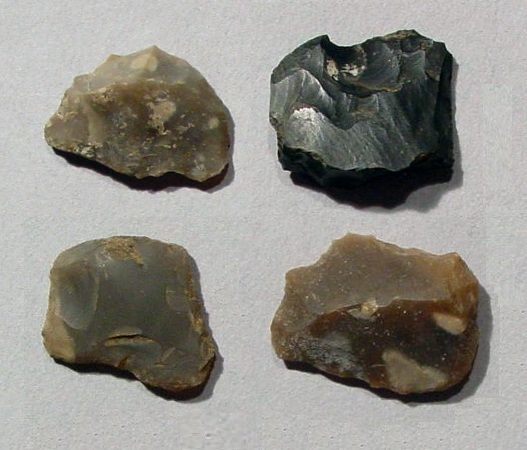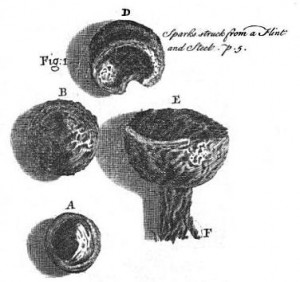
The reader will find online many ‘explanations’ why striking steel against flint produces sparks. Frankly, not all are completely accurate. The best explanation is also the one that is most logical, most reasonable.
Chip Off the Old Block
Freshly broken flint, while somewhat smooth to the eye, if examined microscopically, has a rough surface. Now flint (would you believe it?) is actually harder than steel. So what is the true mechanism whereby one get sparks from steel and chert?
Steel and Flint

When a piece of steel is dragged quickly across a fresh chert surface, very tiny pieces of metal are heated by the friction to a temperature above the ignition point for iron. Iron is the main component of steel. In the presence of oxygen, the steel particle burns at white heat to produce a brilliant spark and a burned out cinder!
Pyrophoric
Does this not seem reasonable to you? Then consider this. Still smaller pieces of iron do not even need friction to ignite them in oxygen. The name applied to a material that burns in this way is pyrophoric. The following brief video explains how you can obtain a suitable source of iron and rock to produce sparks and start a fire!
Note: You might also enjoy Differences Between Fluorescence, Phosphorescence, Incandescence
References:

Friction can create heat, but steel shards burn because of the rapid oxidation of the iron. [Agreed. – Author]
Friction is chemical bonds between two objects, not tiny grooves that run together to make heat. Rough surfaces do create more friction, but it’s because the edges make for better bonds, not because the edges are being pulled apart like puzzle pieces. [As I understand it, the two elements discussed here both contribute. -Author.]
Iron, the main ingredient in steel, is a reactive metal. This means that iron oxidizes (reacts) when exposed to oxygen… All reactive metals are generally considered [to possess a] stable… coating of oxidation on the outside. This coating keeps the rest of the metal from being exposed to air. The coating is only a few molecules deep. This is so thin that [it isn’t readily apparent]. [Yes. -Author.]
So, how flint and steel really works: the harder flint breaks off [extremely finely divided particles] of the steel. The iron… rapidly oxidizes… or… light[s] itself on fire. [The two processes jointly enable high-speed oxidation–sparks. -Author.]
What other striking materials create sparks with steel besides flint? Would you get larger or more sparks with more oxygen such as a forced stream or using pure oxygen? Can you use just iron instead of steel? [Note: edited]
Hi. While I can’t spend much time researching questions of readers in connection with what I write, I believe I can at least present a plausible reasoning in this instance. Keep in mind that it is the surface and the hardness of the flint and the reactivity and the hardness of the iron that are undoubtedly the main factors involved. You probably already know there are metals that react violently with oxygen. The old vacuum tubes in radios had a thin mirror-like coating of cesium metal inside to “get rid” of any last traces of oxygen within. Given enough cesium and enough oxygen, you’d get a flame, to be sure! However, iron is not that reactive. And it is somewhat soft. Steel is harder, and logically more brittle. Little bits of steel can, and are, broken off by the super-fine sandpaper-like surface of the flint. The logical mind might conceive of substituting the flint with a man-made surface. That surface would probably work better than the flint. If the surface were coarser than that of flint, one might not imagine very, very tiny “chunks” being removed by the flint. And if the metal was too soft, the same. So the combination is fortuitous, but logically, could be adjusted, perhaps to improve upon the result slightly.